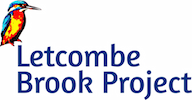Ongoing
We are leading several ongoing projects including the following:
Willow Walk Habitat Enhancement
Aims: Increase Biodiversity, Community Engagement
Management of riverside trees and bankside scrub to improve habitat along a heavily shaded section of the Letcombe Brook. Work started in Oct 2018 and continues with occasional work parties involving the local community. Funding needs to be obtained to carry out more complex canopy reduction by an arborist . Tree management by pollarding and coppicing are ancient techniques that can extend the life of a tree and increase biodiversity.
Letcombe Valley Habitat Enhancement
Aims: Increase Biodiversity, Community Engagement
Installation of locally sourced woody debris to create flow deflectors and narrow areas of over-widened river to increase flow and scour silt from the riverbed. The second phase of this work started in 2018 as a partnership project with the Friends of Letcombe Brook volunteer group.
Invasive Non-native Species Control
Aims: Improve Biodiversity, Community Engagement
LBP are working with landowners and volunteers to eradicate Himalayan Balsam from Letcombe Brook. Although volunteers were already working to reduce balsam on the Brook, a co-ordinated project was launched in 2018. All large stands of balsam in the upper catchment have been mapped and are targeting by hand pulling the plants prior to seeding. In 2019 all stands of balsam as far downstream as East Hanney were targeted and reductions are now being seen in this highly invasive species.
Riverfly Partnership
Aims: Community Engagement, Increase Awareness
Partnership initiative enabling volunteers to monitor the biological water quality of the brook using a simple monitoring technique to detect any severe perturbations in river water quality and contribute information to a national database.
Thames Water Blitz
Aims: Community Engagement, Increase Awareness
LBP take part in the Thames Water Blitz a citizen science project co-ordinated by EarthWatch, UK. The project helps promote freshwater sustainability and draws awareness to pollution issues by using a simple test for nitrates and phosphates to assess the health of our freshwaters and publicise the results on a national database.
Natural Flood Management
Aims: Reduce Flood Risk
We are working to identify sources of silt entering Letcombe Brook and identify areas where silt build up can increase flood risk. Promotion of buffer strips, tree belts and better soil management can all help slow the flow of surface water and reduce flood risk. LBP also look for opportunities to reconnect Letcombe Brook with its flood plain and slow the flow in tributaries and ditches with the installation of leaky dams and large woody debris plus SUDS schemes on housing developments.
Survey Work
LBP need to complete further survey work to inform a Catchment Scale Restoration Plan for the Letcombe Brook. This is critical to ensuring the work we carry out is prioritised, cost effective and delivering on our key aims. Habitat surveys are needed pre and post project to enable us to monitor the success of restoration work, modify restoration techniques and provide accurate information to funders. As other organisations decrease the amount of monitoring and survey work they carry out, its important that LBP are able to keep an eye on water and habitat quality parameters.

